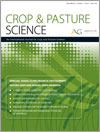
Crop and Pasture Science
Volume 64 Number 4 2013
Clive Francis Festschrift
CP13100The career and contribution to Australian and international agricultural science of Clive McDonald Francis: an introduction
Dr Clive Francis is amongst a small group of scientists whose efforts have changed the face of Australian agriculture. This special issue of Crop & Pasture Science highlights his broadranging impact delivered through the pasture cultivars he bred, the knowledge that he generated and the influence that he had on peers and policy makers. His cultivars of subterranean clover are still grown on many millions of hectares across southern Australia and his efforts were pivotal in generating momentum for creative research on a wide array of crop and pasture legumes, particularly the collection, evaluation and preservation of genetic resources for use in current and future breeding initiatives.
CP13023Strengthening the impact of plant genetic resources through collaborative collection, conservation, characterisation, and evaluation: a tribute to the legacy of Dr Clive Francis
Plant genetic resource collections will play a pivotal role in providing the genetic and adaptive diversity that agriculture needs to feed an increasing population in a depleting resource base. As a tribute to Dr. Clive Francis, who collected >14 000 accessions across 60 genera, we describe the rise and fall of Australian plant genetic resource activities over the last 3 decades, and discuss how core collection and habitat characterization can unlock these collections to stimulate their wider use.
CP13118Genetic improvement of subterranean clover (Trifolium subterraneum L.). 1. Germplasm, traits and future prospects
Subterranean clover is the most important pasture species in Australia, sown over 29 million hectares, and is highly valued as a nutritious feed for livestock and for its ability to improve soil fertility. Following its accidental introduction into Australia with the early settlers, plant selectors have released 45 varieties to farmers since 1900, based on seeds collected in its native Mediterranean basin habitat and from cross-breeding, enabling it to be grown in a wide range of environments and farming systems. The advent of new gene technologies and an understanding of the traits needed for productive, sustainable pastures provides a platform to develop future subterranean clovers with new features that will provide major benefits to the livestock and grains industries.
CP13071Cool-season grain legume improvement in Australia—Use of genetic resources
The cool season grain legumes (field pea, chickpea, faba bean and lentil) are important part of the sustainable cropping systems in Australia and globally. In this paper we review the role and use of genetic resources in the introduction, selection and breeding of the above grain legumes in Australia. Continued use of novel germplasm and use of genomic technologies will enhance the adaptation of cool-season grain legumes to both biotic and abiotic constraints.
CP13092The essential role of genetic resources in narrow-leafed lupin improvement
The narrow-leafed lupin is a legume with much to offer: the production of nutritious, very low glycemic index grain with manifold health benefits on N and P deficient, acid, sandy soils. However, we have exploited only a small fraction of the genetic and adaptive diversity residing in the species, reflecting a short and fragmented domestication history. Given declining global production, unlocking the potential residing in untapped sources of genetic diversity is critical for the future of the crop.
CP13040Habitat and plant diversity of Trifolium tumens (Steven ex M. Bieb.) collected in Azerbaijan and its characterisation and field evaluation in Tasmania, Australia
Trifolium tumens (Talish clover) is a perennial legume species not previously domesticated for use in world agriculture. The species has been identified by pasture researchers in Australia as a having sufficient drought and grazing tolerance. Germplasms have been collected from Azerbaijan in 2004 across 7 agro ecological zones, including 5 climatic zones. This material has been characterised by the Tasmanian Institute of Agriculture (TIA), with promising accessions contributing to a breeding program to develop a commercial cultivar adapted to temperate environments.
CP13054Camelina (Camelina sativa (L.) Crantz): agronomic potential in Mediterranean environments and diversity for biofuel and food uses
The oilseed camelina (Camelina sativa) has potential as a sustainable source of Omega 3 rich food oil, oil for biofuel and high protein meal for stockfeed. The oil from thirty lines of camelina was compared for suitability for different uses and evaluated for selection/improvement through breeding. Field trials proved that camelina can be grown successfully in the wheat belt of Western Australia and the oil evaluation indicated a high degree of genetic diversity that would facilitate breeding.‘
CP13059Australian and Spanish scientists are collaborating in the domestication of tedera: young Merino sheep grazing a monoculture of tedera in autumn showed preference for certain accessions but no signs of ill health
The forage legume tedera can be utilized to fill the autumn feed-gap in Mediterranean-type climates due to its capacity to retain and produce green leaves under drought conditions. Sheep grazing tedera for three weeks in autumn were able to gain weight and condition, showed no signs of ill health and expressed preference for two out of the seven accessions on offer. The information obtained from this experiment is being used by the tedera breeding program in Australia.
CP13073Variability of in vitro ruminal fermentation and methanogenic potential in the pasture legume biserrula (Biserrula pelecinus L.)
Methane is a green house gas (GHG) accounting for 17% of GHG emissions globally and is emitted during fermentation in ruminants. This study of methane in in vitro fermentation from glasshouse-grown samples of a world collection of the pasture legume biserrula showed markedly lower methane production than the controls and also variation among biserrula samples. The bioactivity of one biserrula cultivar also persisted in the field, indicating scope to select biserrula as an elite methane-mitigating pasture legume.



